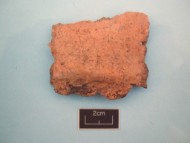

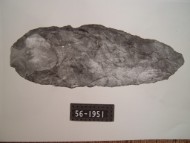
Rough-out stone axe, an adze or axe, and a shard of Bronze age pottery all found at Cummersdale.
Cummersdales first inhabitants
The terrace above the Caldew valley on which the present High Cummersdale village is situated was formed about 15,000 years ago during the last ice age. Over the following seven or eight thousand years, as the ice cap receded and temperatures began to rise, the growth of vegetation was encouraged and hunters ventured along the coast and up the river valleys in search of food. The evidence that these nomadic tribes left, however, is very sparse and unfortunately there is no concrete evidence of them at Cummersdale.
We are more fortunate with later tribes. Neolithic man left more evidence of where he had been, and at Cummersdale quite a few worked flints have been recovered. In addition to worked flints being recovered, two stone axes have also been found in the Cummersdale area, one in 1946 and another in 1951. From the present evidence we know that the first settlers here at Cummersdale were late neolithic people, although the actual settlement or living area has not yet been located. There is some Bronze Age evidence from both Brow Nelson and High Cummersdale, Brow Nelson also produced Iron age/Romano British evidence, which includes a crop mark site. Roman activity is evident to the East of High Cummersdale village with two known sites, a possible Roman fort of the early 2nd century, and in the adjacent field a 4th century farmstead.

The double ditch of a Roman Camp or Fort behind Gilbert Road.
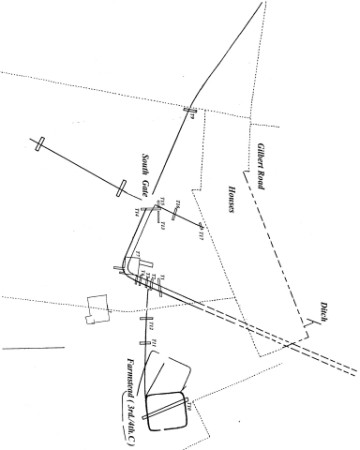
Plan of trenches across the two ditches and the single trench across the Roman Farmstead in the next field.

The Roman pottery found during the excavations.
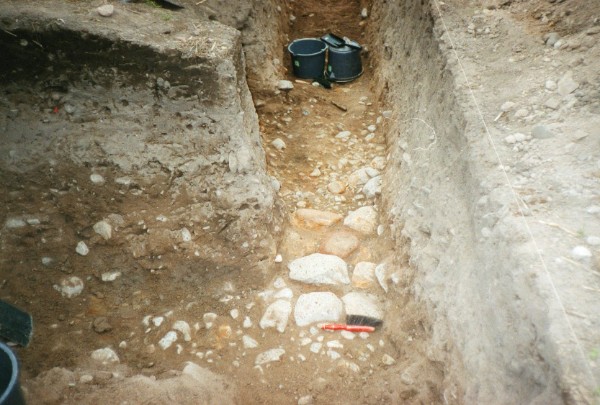
The foundation wall of a 4th century farm house at Cummersdale

Italian students from the University of Macerata, on the excavation at Cummersdale
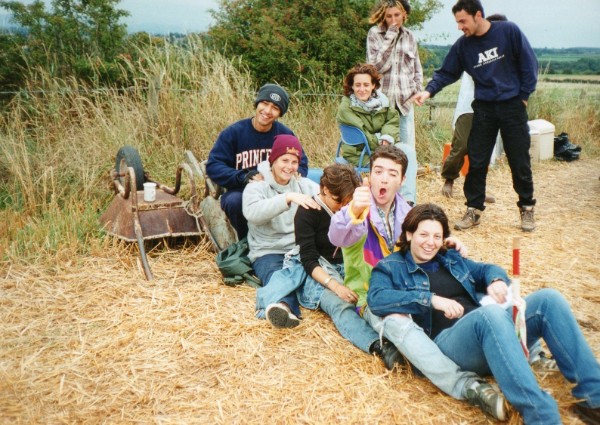
More of the students from the Universitiesof Macerata and Catania, Italy.

Some of the students from the University of Manchester
From when the Romans were here until about the 12th century little is known of settlers in the area, pottery shards give some indication of the few inhabitants. Because of the unsettled situation in the borders, landowners were reluctant to live outside the protective walls of Carlisle. They employed tenant farmers to work their lands outside the fortifications of the city. The de Carlisles, Robert of Whitrigg, Walter of Kirkbampton, William de Monte Acuto, Alan de Pennington are just a few of the landowners at Cummersdale in the 13th and 14th centuries. In addition to these, the church also owned lands and properties at Cummersdale. The Bishops register for 1318 records him being the owner of a fulling mill and the corn mill at Cummersdale.
For many years, the areas outside the walled city of Carlisle suffered at the hands of the Scots, and later, the border rievers.Some very serious incursions took place with properties ransacked and burned, livestock stolen and in some cases the inhabitants killed. The Cummersdale district as with other areas around Carlisle were sparsely populated during these centuries.
More trouble came during the siege of Carlisle in 1644 / 45 when many of the skirmishes took place in and around Cummersdale, these are graphically described in Issac Tullies published account of the siege. He also records that one of the last acts of the starving garrison in Carlisle castle was to send out a party of horsemen to Cummersdale mill for corn to feed the starving occupants.
Many Cumbrians thought that with the coming together of the Crowns and then the settlement in 1706 they could at last look forward to a more peaceful life, however, in 1745 Charles Edward Stuart (Bonnie prince Charlie) caused quite a panic in and around Carlisle on his way South to lay claim to the Throne. He and his highlanders crossed over Cummersdale Moor and through the village on his way to set-up his headquarters at Blackwell
The earliest mention of the corn mill at Cummersdale is in 1268, in a quit claim by Nicholas, the son of William de Charpent, of his rights in Little Cummersdale and the mill to Robert, Bishop of Carlisle. In 1282 the mill is still held by the church , for in an inquisition taken at he death of Ralph de Irton in that year, among the sources of revenue mentioned is the rent of the mill of Cummersdale, and later in the in the Bishops register of 1318 the mill was to let three years in a row, paying 100 shillings rent. Much later in a document dated the 8th June 1612 the Howards of Corby are recorded as owners of the corn mill and the fulling mill including lands and estate at Great Cummersdale. In 1637-38 the mills were let again to Thomas and Christopher Blenehasset. Later documentary evidence of the mill comes from Isaac Tulies account of the siege of Carlisle in 1644 -45. Whether the Mill referred to by Tullie occupied the same site as the earlier mentioned thirteenth century mill is not known. Tullie records that a party of horsemen rode out to Cummersdale mill for corn to feed the starving garrison within the Castle at Carlisle. In 1656 Sir Francis Howard and his son , Francis, let the mill. By 1689 Henry Broughham, of Broughton Hall, Westmoreland, owned the mill. In an agreement of that date, Henry paid George Topping of Cummerdsdale five pounds of current English money for the lease of Cummersdale mill. By 1701, another local man, John Forster, had decided to buy the mill. He paid £549 to Henry Broughham. The deal was carried out through Henrys agent, John Stockdale of Penrith. By 1775 the corn mill was advertised to let in the local papers. The advert gives a discription of the mills contents and workings. It was fitted with blue and grey mill stones, and also included in the tenancy was a barley mill an drying kiln. There was also other buildiings and five acres of land with the mill. The mill was re-built in 1782, the new mill was three storeys high and was fitted with three and was fitted with three pairs of stones; Blue, Grey and French.The millstones were situated on the top floor of the building. The second floor contained a dresser for cleaning the grain, and also a bolting mill,- a large cylinder, which with little labour sorts and sacks the flour down to the ground floor of the building. Also built along side the new mill was a drying kiln with the capacityto dry forty bushels at a time. Mr John Forster of Carlisle was the owner of the new mill. In 1808 Mr John Dalton rented the mill. He was assisted by his father, Thomas, who had previously been the keeper of the poorhouse in Carlisle. Ten years later tragedy struck the Dalton family when Thomas, delivering some flour to Blackwell in his horse and cart, had crossed the river Caldew at the Bay Head. During the time that elapsed while making the delivery the river had swollen in consequence of heavy rain in the hills. On his return journey the elderly Thomas attempted to cross the river in his cart, but the horse was unable to stand the violent current and was carried downstream, and both Thomas and the horse were drowned. The letting of corn mills seem to happen every ten or twelve years, going by the adverts in the local papers. At one time two corn mills were advertised at Cummersdale, the site of one was at the bottom of the hill road on the right near the lagoon, and the other, according to an old map was sited on the bend of the river where the present mill stream out-let from the print works is today. In Victorian times bakers were always looking for a white bread, this could never be achieved with stone ground flour. By late Victorian times the milling industry was begging to feel the effects of modernisation. Before selling the corn mill in 1886, the Dalton family renovated the mill and its machinery, adding the new Hungarian roller systemfor crushing grain. Also fitted at the same time were wind and sieve purifiers, which were designed to eliminate the brown fluff that was so objectionable in the old process of flour making. The new machinery was capable of grinding four sacks of wheat and hour, which was a considerable increase on the old system. It also had the added bonus of grinding up up the shorts and seconds into fine flour. These had previously been sold at a lower price. The newly renovated mill also now had a dual source of power, water and steam, giving a combined fifty horse power. Twenty years later (1905) the mill buildings were sold to Stead McAlpin print-works. A survey by Mr Pattinson Dalton's legal council carried out a survey. the properties to be sold were the corn mill, the two cotton mills and 39 workers cottages, Daltons council asked for £12,000 for the properties, but Mr Stead finally paid ££10,000. Also included in the sale were parcels of land and the mill stream water rights. The corn mill buildings were let to the Abbotsford Tweed mill company until 1914, they then were used by Stead McAlpin as a store for their large collection of wooden printing blocks. The buildings were finally demolished in the 1970's. It was around the corn mill that Cummersdale mills village evolved. ( also see photo on next page).

The Corn Mill building on the left, with Mill House centre left,